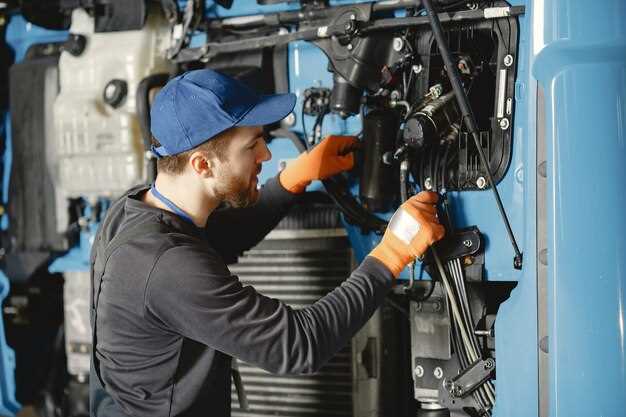The Importance of Regenerative Braking Maintenance

Regenerative braking systems are a pivotal innovation in modern automotive engineering, playing a crucial role in enhancing energy efficiency and reducing wear on traditional braking components. These systems harness kinetic energy that would otherwise be lost during braking and convert it into electrical energy, which is then stored in the vehicle’s battery. Despite their benefits, the effectiveness of regenerative braking systems can diminish over time if not properly maintained.
Regular maintenance of regenerative braking systems is essential to ensure their optimal performance and longevity. Worn components, dirt build-up, and software issues can impede the system’s ability to capture energy efficiently. This can lead to increased energy consumption, reduced battery life, and ultimately compromise the vehicle’s overall performance. In fact, neglecting maintenance can result in costly repairs down the line, making it imperative for vehicle owners to prioritize regular check-ups and servicing.
Furthermore, the safety implications of an underperforming regenerative braking system should not be underestimated. Effective braking is vital for safe driving, and any degradation in performance could potentially jeopardize the driver’s safety and that of others on the road. Therefore, understanding the importance of routine evaluation and maintenance of these systems is not just a matter of efficiency, but also of safety and reliability in everyday driving experiences.
Understanding the Components of Regenerative Braking Systems
Regenerative braking systems are designed to capture kinetic energy during braking and convert it into electrical energy. This process not only enhances energy efficiency but also reduces wear on traditional braking components. Understanding the key components involved in regenerative braking systems is essential for appreciating their functionality and the importance of regular maintenance.
| Component | Description |
|---|---|
| Electric Motor | The primary component that serves as both a motor and a generator. When decelerating, it converts kinetic energy into electrical energy, which can be stored for later use. |
| Power Electronics | This subsystem manages the flow of electrical energy within the system, including the conversion of AC to DC and controlling the motor’s operational mode during braking. |
| Energy Storage System | Typically comprised of batteries or supercapacitors, this component stores the electrical energy generated during braking for reuse in propulsion or other vehicle systems. |
| Brake Pedal Sensor | This sensor detects the driver’s intent to brake and communicates with the control system to optimize the balance between regenerative and conventional braking. |
| Control Unit | This central unit coordinates all aspects of the regenerative braking process, ensuring that energy recuperation is maximized while maintaining vehicle stability and safety. |
| Traditional Braking System | While regenerative braking significantly enhances efficiency, traditional friction brakes are still present to provide additional stopping power when necessary and to ensure safety in emergency situations. |
Each of these components plays a vital role in ensuring effective energy recovery during braking events. Regular maintenance of these systems ensures optimal performance, enhances vehicle longevity, and improves overall safety on the road.
Common Issues in Regenerative Braking: Signs to Watch For
Regenerative braking systems are designed to capture energy during braking and convert it back into usable power, contributing to overall efficiency in electric and hybrid vehicles. However, like any technology, these systems can experience issues over time. Recognizing the warning signs early can prevent more significant problems down the line.
One common issue is a noticeable decrease in braking efficiency. If the vehicle takes longer to stop or if you feel that the brakes aren’t engaging as they should, it may indicate problems with the regenerative braking system. This could stem from worn components or electrical issues within the system.
Another sign to watch for is unusual noises during braking. If you hear grinding, squeaking, or buzzing sounds, this might indicate that the brake pads or rotors are worn out, or that there are issues with the electrical components of the regenerative braking system. Addressing these sounds early can prevent further damage.
Inconsistent braking feel can also indicate issues. If the brakes feel spongy, hard, or unresponsive, it may suggest a problem with the brake fluid, a leak in the hydraulic system, or faulty sensors that affect regenerative braking. Regular checks can help identify these problems before they worsen.
A malfunctioning dashboard warning light is another critical sign. If the battery or braking system lights appear, or if you receive a specific message concerning the regenerative braking system, it’s essential to respond promptly. Ignoring these warnings can lead to more severe system failures and compromised vehicle safety.
Battery performance changes can also indicate issues with the regenerative braking system. If the state of charge seems to decrease more rapidly than expected, or if the vehicle fails to recharge the battery when decelerating, it may signal problems with the system capturing energy effectively.
Finally, frequent service visits required for brake components can be an indicator of underlying issues within the regenerative braking system. If brake pads wear out more quickly than usual or if maintenance is needed sooner than recommended, it might be time to have the system thoroughly inspected.
Being vigilant about these signs can help ensure your regenerative braking system operates efficiently, ultimately enhancing safety and performance while reducing repair costs.
Regular Inspections: Critical Checks for Optimal Performance
Regular inspections of regenerative braking systems are essential for ensuring their efficiency and longevity. Neglecting these checks can lead to decreased performance, increased wear, and even safety hazards. Below is a list of critical components to inspect during regular maintenance:
- Brake Pads and Discs:
Inspect brake pads and discs for wear and tear. Uneven wear might indicate alignment issues or problems with the braking system, which could impair regenerative braking efficiency.
- Battery Health:
The effectiveness of regenerative braking is closely tied to the condition of the battery. Regular tests should be conducted to assess battery capacity and performance under load to ensure it can efficiently store regenerated energy.
- Electrical Connections:
Check all electrical connections related to the regenerative braking system. Ensure that there are no loose or corroded connections, as this can lead to power loss and system inefficiencies.
- Control Software:
Firmware and control software should be updated regularly to take advantage of performance enhancements and bug fixes. Verify that the software settings are optimized for the specific vehicle type.
- System Calibration:
Calibrate the regenerative braking system to ensure proper engagement and disengagement. Calibration checks can prevent excessive wear and maximize energy recovery during braking.
In summary, regular inspections are vital for maintaining optimal performance of regenerative braking systems. These checks not only enhance efficiency but also contribute to the overall safety and reliability of the vehicle. Incorporating these inspections into maintenance routines can lead to significant improvements in energy savings and vehicle lifespan.
Impact of Neglected Maintenance on Vehicle Efficiency

Neglected maintenance of regenerative braking systems can lead to significant declines in vehicle efficiency. Over time, components such as brake pads, rotors, and electrical systems can deteriorate, reducing the effectiveness of the braking process. This inefficiency results in increased energy consumption, as the vehicle may rely more on conventional braking methods that do not recover energy.
When regenerative braking systems are not regularly inspected or serviced, contaminants such as dust, grime, and moisture can accumulate. This buildup can cause a decline in friction performance, leading to reduced energy regeneration during braking. Consequently, the vehicle’s overall energy economy suffers, which can have a direct impact on range, particularly in electric and hybrid vehicles.
The use of worn-out components can also lead to increased wear on the vehicle’s electric motor and battery systems. For instance, inefficient braking forces the system to work harder, which may drain the battery more quickly and reduce its lifespan. The net effect is a cycle of decreasing performance and efficiency that can require costly repairs or replacements down the line.
In summary, neglecting maintenance of regenerative braking systems not only hinders immediate braking performance but also adversely affects the vehicle’s long-term efficiency. Regular checks and upkeep are essential for optimal energy recovery, cost-effectiveness, and the sustainability of vehicle operation.
Cost-Benefit Analysis of Routine Maintenance for Regenerative Brakes
Routine maintenance of regenerative braking systems is essential for ensuring optimal performance and longevity. The cost-benefit analysis of such maintenance involves evaluating the financial implications against the potential benefits obtained from regular servicing.
The primary costs associated with routine maintenance include labor fees, replacement parts, and diagnostic services. Mechanics may need to inspect brake pads, electrical components, and hydraulic systems, which can add up over time. However, these costs are minimal when compared to the potential expenses incurred from neglecting maintenance. For instance, failure to address minor issues like worn brake pads could lead to more extensive damage, resulting in expensive repairs and prolonged downtime.
On the benefit side, maintaining regenerative brakes enhances vehicle efficiency. Properly functioning brakes contribute to improved energy recovery, extending the overall range of electric and hybrid vehicles. This efficiency translates directly to fuel savings and reduced operational costs in the long run, providing a compelling financial incentive for regular maintenance.
Additionally, consistent upkeep ensures enhanced safety. A well-maintained braking system is crucial for optimal vehicle control and security, reducing the likelihood of accidents. The safety aspect not only protects the driver and passengers but also minimizes potential liability costs associated with accidents caused by brake failure.
Moreover, regular maintenance can significantly boost the resale value of vehicles equipped with regenerative braking systems. Prospective buyers often look for well-documented maintenance records, and having a history of regular upkeep can justify a higher asking price.
In conclusion, while the initial costs of routine maintenance for regenerative brakes may appear substantial, the long-term benefits–ranging from enhanced efficiency and safety to increased resale value–greatly outweigh those costs. Investing in regular maintenance is not only financially sound but also vital for the performance and reliability of regenerative braking systems.
Best Practices for Maintaining Your Regenerative Braking System
Maintaining your regenerative braking system is crucial for maximizing efficiency and ensuring safety. Here are some best practices to follow:
1. Regular Inspections: Conduct regular inspections of the braking system. Look for signs of wear in components such as rotors, pads, and the electrical systems that control regenerative braking. Address any issues promptly to prevent further damage.
2. Brake Fluid Checks: Ensure that the brake fluid is at the recommended levels and free from contamination. Old or dirty fluid can hinder braking performance and impact the regenerative system’s efficiency. Replace the fluid as per manufacturer recommendations.
3. Monitor Brake Performance: Pay attention to the braking performance during normal operations. A sudden change in responsiveness or unusual noises can indicate an underlying issue that needs to be diagnosed and corrected.
4. Battery Maintenance: Since regenerative braking is closely linked to the vehicle’s battery system, keep the battery charged and in good condition. Regularly check for corrosion on terminals and ensure secure connections to optimize energy recovery during braking.
5. Software Updates: Stay informed about any software updates for your vehicle’s braking system. Manufacturers often release updates to enhance performance or fix issues related to regenerative braking. Regularly check for updates and implement them as needed.
6. Training and Awareness: Educate yourself and other drivers about how regenerative braking operates. Understanding the system helps in utilizing it effectively, contributing to its longevity and performance.
7. Use Genuine Parts: When replacing components, opt for genuine parts specifically designed for your vehicle. Using non-genuine parts may compromise the functionality and efficiency of the regenerative braking system.
8. Avoid Overheating: Be mindful of how often and how hard you brake, especially in demanding conditions. Overheating can damage the braking components and reduce the system’s regenerative capabilities. Aim for smooth, gradual braking whenever possible.
9. Professional Servicing: Schedule professional maintenance checks at regular intervals. Trained technicians can provide a thorough inspection, ensuring all components of the regenerative braking system are functioning correctly and safely.
Following these best practices will help maintain your regenerative braking system, enhance vehicle efficiency, and promote safer driving experiences.
